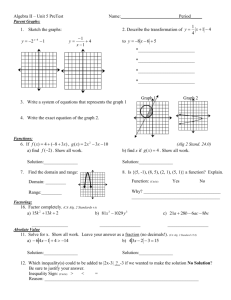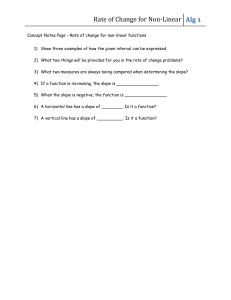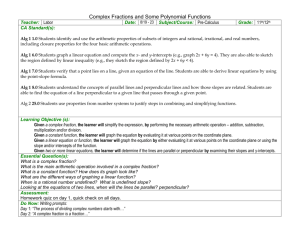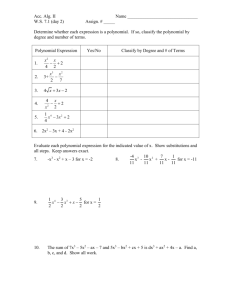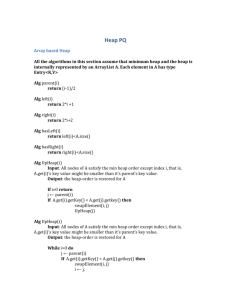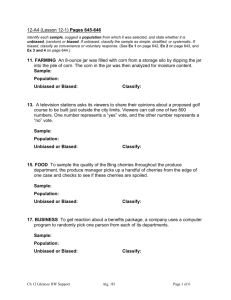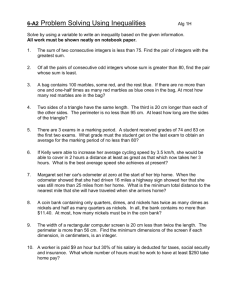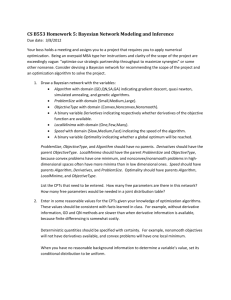Analysis of Algorithms
advertisement
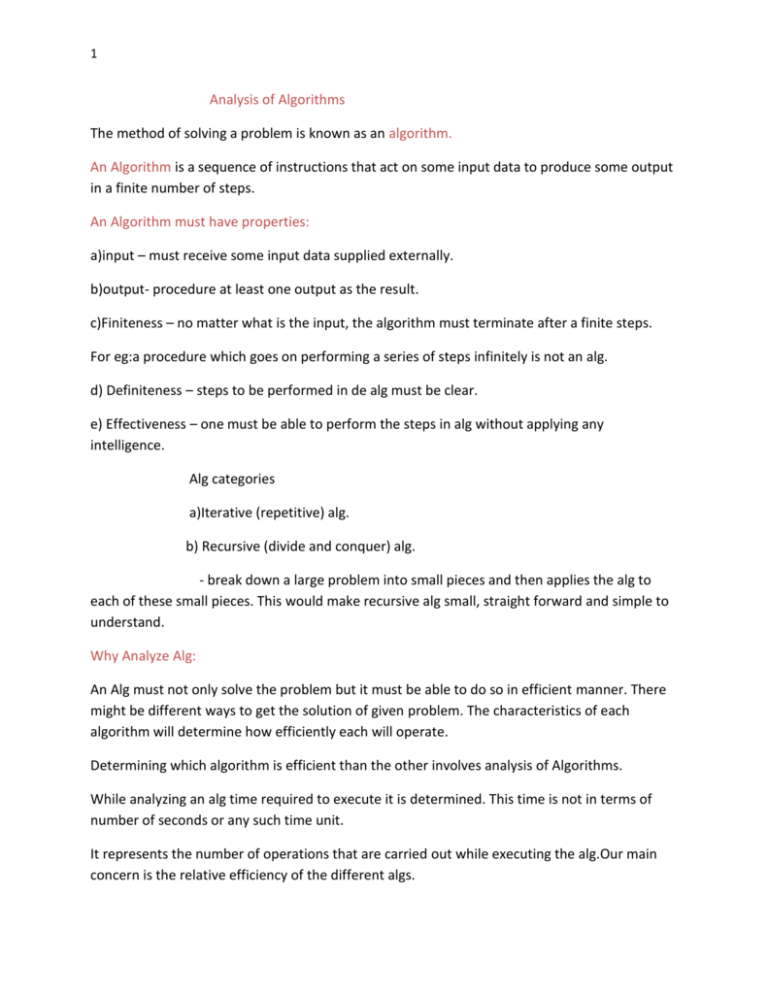
1
Analysis of Algorithms
The method of solving a problem is known as an algorithm.
An Algorithm is a sequence of instructions that act on some input data to produce some output
in a finite number of steps.
An Algorithm must have properties:
a)input – must receive some input data supplied externally.
b)output- procedure at least one output as the result.
c)Finiteness – no matter what is the input, the algorithm must terminate after a finite steps.
For eg:a procedure which goes on performing a series of steps infinitely is not an alg.
d) Definiteness – steps to be performed in de alg must be clear.
e) Effectiveness – one must be able to perform the steps in alg without applying any
intelligence.
Alg categories
a)Iterative (repetitive) alg.
b) Recursive (divide and conquer) alg.
- break down a large problem into small pieces and then applies the alg to
each of these small pieces. This would make recursive alg small, straight forward and simple to
understand.
Why Analyze Alg:
An Alg must not only solve the problem but it must be able to do so in efficient manner. There
might be different ways to get the solution of given problem. The characteristics of each
algorithm will determine how efficiently each will operate.
Determining which algorithm is efficient than the other involves analysis of Algorithms.
While analyzing an alg time required to execute it is determined. This time is not in terms of
number of seconds or any such time unit.
It represents the number of operations that are carried out while executing the alg.Our main
concern is the relative efficiency of the different algs.
2
Note: An alg cannot be termed as better because it takes less time units or worse because it
takes more time units to execute. A worse alg may take less time units to execute if we move it
to a faster computer, or use a more efficient language.
Hence while comparing two algs it is assumed that all other things like speed of the computer
and the language used are same for both the algs.
We cannot says these actual number of operation while computing the alg, because depend on
the input size the number of operation vary for same alg.(eg:sorting).
Once the equations for two algs are formed we can then compare the two algs by comparing
that rate at which their equations grow. This growth rate is critical since there are situations
where one alg needs fewer operations than the other when input size is small, but many more
when the input size gets large.
Why analyze Alg:
Book data structure through c Pg:2to6
How to analyze an alg:
Eg: count = 0
While there are more characters in the file do
Increment count by 1
Get the next character
End while
Print count
If there are 500 characters present in the file we need to initialize count once, check the
condition 500+1 times( the +1 is for the last check when the file is empty),and increment the
counter 500 times. The total number of operation is:
Initialization -1
Increments -500
Conditional checks -500 +1
Printing -1
3
No: of increments and conditional are far too many as compared to no: of initialization and
printing operation.
No: if of initialization and printing operation would remain same for any size. while doing
analysis of this algorithm the cost of the initialization becomes meaningless as the number of
input values increases.
It is important what to analyzing an algorithm-Identify significant operation like comparison or
arithmetic.
Comparison operations-equal, not equal, less than, greater than, less than or equal and greater
than or equal. Arithmetic operation has two groups additive(addition,subtraction,increment,
decrement) and multiplication(multiplication,division,modulus).
Note: multiplication operation take longer time to execute than additions.
Complexities
a) Best case Input
-Input set that allows an algorithm to perform most quickly.
-takes shortest time to execute (causes the algorithms to do least amount of work)
For eg:
In search algorithm if the value we are searching for is found in first location. As the result, this
algorithm needs only one comparison. No matter how large is the input, searching in a best
case will result in a constant time of 1.Since the best case would very small and frequently
constant value , a best case analysis is often not done.
b) Worst Case Input
-The input set that allows an algorithm to perform most slowly. Worst case in an important
analysis because it gives us an idea of the most time an algorithm will ever take.
-Worst case analysis requires that we identify the input values that cause an algorithm to do
the most work.
For eg:
In search algorithm, the value we search for would be in last place or is not in the list. This
involve comparison of N (consider N element in the list) .
4
c) Average Case Input-The input set that allows an algorithm to deliver an average
performance.
4 steps:
1) Determine the number of different groups into which all possible input sets can be divided.
2) Determine the probability that the input will come from each of these groups.
3) Determine how long the algorithm will run for each of these groups. All of the input in each
group should take the same amount of time, and if not the group must be split into two
separate groups.
Calculate average case time using the formula:
A (n)=∑𝑛𝑖=1 pi ∗ Ti
n=size of input
m=number of groups
pi=Probability that the input will be from group i.
ti=Time that the algorithm takes for input from group i.
Efficiency of an algorithm:
-denotes the rate at which an algorithm solves a problem of size n.
-measured by amount of resources it uses, the time and space.
Time refers –number of steps the algorithm executes
Space refers-number of unit memory storage it requires.
An algorithm’s complexity is measured by calculating the time taken and space required for
performing the algorithm.
Time complexity:
An algorithm is amount of time needed by a program to complete its task(i.e)to execute a
particular algorithm. The number of steps required by an algorithm varies with the size of the
problem it is solving(input).The time taken for an algorithm is comprised of two times.
5
a)compilation time
b) run time
Compilation time:
-is time taken to compile an algorithm (it checks syntax and semantic errors in the program and
links it with the standard libraries)
-is not in the control of the programmer, as the compiler (depends upon the programming
language) takes it own time to compile a particular program.
-compilation time is always dependent upon the compiler, since different compilers can take
different times to compile the same program.
-so ignore the outcome of the compile time for computing the efficiency of the alg and consider
only the run time.
Run time:
-is the time to execute the compiled program.
-it depends upon the number of instructions present in the algorithm (one unit for executing
one instruction).
Note: Run time is calculated only for executable statements and not for declaration
statements.pg1.21 (data structure using c p.sudharsan)
Worst case:denonted by f(n)=𝑛2 or f(n)=n log n.we write T(n)=o(f(n)) for the worst case time
complexity.This means the algorithm will take no more than f(n)operation.
Average case: depends on the probability distribution of instances of the problem.
Best case:denonted by f(n) such as f(n)= 𝑛2 or f(n)=n log n .We write T(n)=Ω(f(n))for best case.
When the worst and best case performance of an algorithm are the same we can write
T(n)=θf(n).
Space complexity:
-is a amount of memory consumed by the alg (apart from the input and output, if required by
specification)until it completes its execution.
-amount of storage space required by an algorithm varies with the size of the problem to be
solved.
6
a) A fixed amount of memory occupied by the space for the program code and space occupied
by the variable used in the program.
B) A variable amount of memory occupied by the component variable whose size is dependent
on the problem being solved. This space increases or decreases depending upon whether the
program uses iterative or recursive procedures.
Memory space taken by the variables is in the control of a programmer. More the number of
variables used, more will be the space taken by them in the memory.
They are,
a)instruction space
b)data space
c)environment space
Instruction space:
-is the space in memory occupied by the compiler version of the program.We consider this
space as constant space for any value of n.The instruction space is independent of the size of
the problem.
Data space:
-is a space in memory,which used to hold the variables,data structures,allocated memory and
other data elememts.The data space is related to the size of the problem.
Environment space:
-is a space in memory used on run time for each function call.
-holds the returning address of the previous function.
Eg:iterative factorial
fact(long n)
{for (i=1;i<=n;j++)
X=i*x;
Returm x;
}
7
Space occupied is
Data space:I,n,x
Environment space:almost nothing because the function is called only once.
The space complexity remains the same since the same variables are used,and the function is
called only once.
Recursive factorial eg:
Long fact(long x)
{
If (x<=1)
Return(1);
Else
Return(x*fact(x-1));
}
Data space:x
Environment space:fact() is called recursively ,and so the amount of space this program used is
based on the size of the problem.
Performance analysis
The performance-analysis function probes for bottlenecks in server-hardware
performance, diagnoses the problem, and suggests ways to improve the
performance.
The Performance Analysis icon is displayed as one of six images, each of
which represents a different meaning:
This icon blinks to indicate that performance analysis is in progress.
The performance-analysis is complete. The Report Viewer freezes
while the results are loaded for viewing.
8
The performance-analysis report is ready and has no bottleneck
recommendations, but the Details section of the report may discuss
some bottlenecks or latent bottlenecks.
The performance-analysis report is ready, and you have system
bottlenecks.
The performance-analysis report could not be created. One or more
critical monitors might be missing.
Performance analysis is disabled. To re-enable performance analysis,
click Edit > Enable Performance Analysis.
Tips:
By default, Capacity Manager activates all the required performanceanalysis monitors that are present on the systems.
Performance analysis is available only on the following operating
systems that have all the required performance-analysis monitors:
Linux®
Windows® 2000
Windows 2003
Windows Server 2008
Windows Vista
Performance-analysis algorithm
The performance-analysis algorithm is based on the practices of experts.
The algorithm can find most but not all system problems.
The algorithm uses these monitors for Windows®:
Memory Usage
% Disk Time
CPU Utilization
9
Depending on the operating system you use, any of the following
monitors to reflect LAN adapter performance:
Packets/sec
Total Bytes/sec
% Network Utilization
The algorithm uses these monitors for Linux®:
Used Non-Cached (MBytes)
I/O operations/second
CPU Utilization
Any of the following monitors to reflect LAN adapter performance:
Bytes/second
Packets/second
Asymptotic Notations:
Analyzing an algorithm allows us to estimate the time it will take to complete its task,find and
eliminate wasteful code, or alert us when algorithm we choose is very slow.This complexity
analysis characterize the relationship between the size the data and resource usage with a
simple formula.The notations are methods used to estimate the efficiency of an algorithm.
Pg
